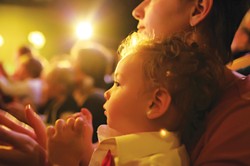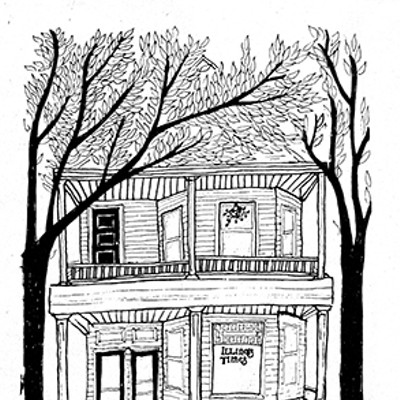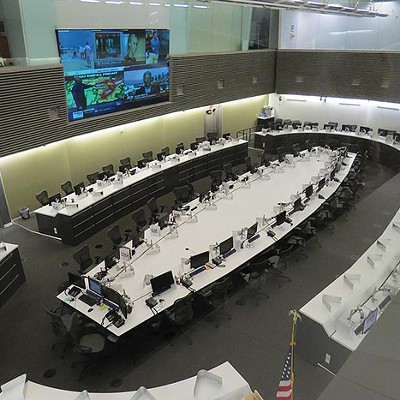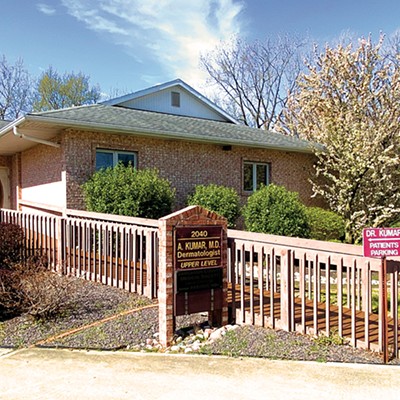While visiting an old friend in Evanston last weekend, I attended a Ceremony of Lessons and Carols at Northwestern University’s Millar Chapel. It was typical of such performances – hard benches and good music, and this time a polite “says who?” delivered to the scare-mongers among us in the form of lessons delivered in Spanish and chanted from the Qu’ran.
In the pew in front of me was a mother with two little girls – French, I guessed. The little one was understandably a little squirmy upon being told that the seed of woman shall bruise the serpent’s head. After 20 minutes or so they slipped out soundlessly, with smiles of apology to the rest of us.
I am unlikely to get a nicer gift this Christmas. My experience with children at such events is not always so pleasant (although they are less annoying than wrapper crinklers, cellphone gazers and coughers). Apart from the obvious exception of performances intended for the proto-persons among us, the presence of small children is no more appropriate in a theater, concert hall or museum than in, say, a school board meeting, their parents’ bedchamber or any other place where things are going on they can’t understand and wouldn’t approve of if they did.
Naturally, some parents disagree. Susie Mesure, a journalist for Britain’s The Independent, recently complained in print about London’s Royal Court Theater for allowing under-ones to attend only special showings of their productions. “That,” she complained, “dooms new parents to years of evenings in.” No, it is not the theater’s strict ban on babies that dooms new parents to years of evenings in, Ms. Mesure, it is having babies. Mind, I’m all for people having babies – they’ll be covering my Social Security checks for the next 20 years – but I am dead set against their having babies everywhere.
Consider the art museum that finds itself hosting parents who believe it appropriate for their tax deductions to “engage” with the art as a form of play. Dea Birkett, director of a British domestic terrorist cell calling itself Kids In Museums, explained to a reporter, “A simple copy of an artwork which they can reach out and touch will do” (except that having been told it’s okay to touch one they will want to touch them all) “or a jigsaw of the portrait before them. They can draw a picture on the floor, capturing what’s on the walls. These are all gentle activities any young child will enjoy.”
At most of the shows I’ve been to, such a child will get gently trampled by Russian tourists looking for a place to sneak a smoke. A saner approach was that taken by the Illinois State Museum in providing separate children’s areas and programs within their buildings. Up in the city, the Lyric Opera does not allow babies in the theater. The Chicago Symphony Orchestra discourages children under eight at concerts and does not permit those under two at all, and asks that disruptive children above that age leave the hall. (Monitors are provided in the lobbies so they can watch and listen there; I call that civilized.) The Goodman Theatre states “Babes in arms are not permitted.” At Ravinia children ages 15 and under are admitted free to the lawn for most performances, but no children under 7 years of age are admitted to reserved seats except for designated family shows. The Art Institute allows under-14s in for free (today’s bored tweener is tomorrow’s dues-paying member) but tries to entice them away from the galleries. Most suburban venues impose age restrictions according to the nature of the performance.
Folks hereabouts take an attitude that you might find more tolerant or more lax, depending on how much you paid for your ticket on the night when somebody’s ankle-biter ruined the show. The Sangamon Auditorium not only admits infants and toddlers, it provides booster seats. Hoogland not only admits kids but gives parents a break on the ticket price for kids under 12 and lets lap-sitting under-fours in free. Over in Urbana, Krannert allows them; so does the Kirkland in Decatur.
My readers have come to expect me to provide them with answers regarding all things, but I can’t explain these differences in policy. Is it because most of what goes on in the city venues is understood to be Art, while our Downstate halls devote themselves to entertaining audiences who see the stage as a home media center come to life? Does social class have something to do with it, as it does with everything else? After all, uppers and upper-middles who patronize the arts in the city see going out as a way to escape the children for an evening, while the middles and lower-middles see it as a chance to do something with the kids.
If you have better explanations, let me know. They don’t have to be correct. Hey, if guessing the answers to all complicated questions is acceptable for Republican presidential candidates, why can’t the rest of us do it?
Contact James Krohe Jr. at [email protected].
Childproofing culture
Should children be permitted in cultural venues?
[
{
"name": "Air - MedRect Combo - Inline Content 1",
"component": "11490391",
"insertPoint": "3",
"requiredCountToDisplay": "1",
"parentWrapperClass": "fdn-ads-inline-content-block"
},{
"name": "Air - MedRect Combo - Inline Content 2",
"component": "11490392",
"insertPoint": "7",
"requiredCountToDisplay": "5",
"parentWrapperClass": "fdn-ads-inline-content-block"
},{
"name": "Air - MedRect Combo - Inline Content 3",
"component": "11490393",
"insertPoint": "12",
"requiredCountToDisplay": "9",
"parentWrapperClass": "fdn-ads-inline-content-block"
}
]
Illinois Times has provided readers with independent journalism for almost 50 years, from news and politics to arts and culture.
Your support will help cover the costs of editorial content published each week. Without local news organizations, we would be less informed about the issues that affect our community..
Got something to say?
Send a letter to the editor and we'll publish your feedback in print!






















